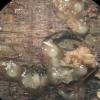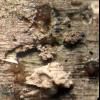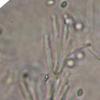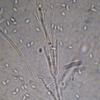
17-12-2025 18:35
 Michel Hairaud
Michel Hairaud
Bonjour à tous/Hi to everyone I am passing along

15-12-2025 15:48
 Danny Newman
Danny Newman
Melanospora cf. lagenaria on old, rotting, fallen

15-12-2025 15:54
 Johan Boonefaes
Johan Boonefaes
Unknown anamorph found on the ground in coastal sa

15-12-2025 21:11
 Hardware Tony
Hardware Tony
Small clavate hairs, negative croziers and IKI bb

15-12-2025 07:09
 Danny Newman
Danny Newman
indet. Rutstroemiaceae sp. on unk. fallen leavesMc

15-12-2025 07:05
 Danny Newman
Danny Newman
Pseudosclerococcum golindoi (det: Zotto)near Cosb

15-12-2025 11:49
 Danny Newman
Danny Newman
ITS sequences from the following two collections B

15-12-2025 12:34
 Danny Newman
Danny Newman
indet. Rhytismataceae on oak leafnear Purchase Roa
Synnematal fungi from Fagus wood
Alex Akulov,
22-08-2010 14:35
 Synnemata scattered, gregarious to caespitose, gelatinose, spherical, with wide prostrate base, but without stipe, typically whitish when fresh and yellowish-brown after drying; quickly soaked and lighter in the water, but virtually no change color in KOH. Conidiophores branching 2-3-level verticillate or irregularly biverticillate, resemble those of the Stilbella flavipes. Phialides in terminal or intercalary whorls of 3-6, or lateral and terminal, cylindrical to subulate, straight or sinuous, that placed an acute angle to the conidiophore axis, sometimes with irregular constrictions, 22-38 µm long, 1.4-1.9 µm wide, Conidia ellipsoidal to ovoid, 3.1-4.1 (-5.0) x (1.7-) 2.0-2.3 µm, sometimes grouped in the tops of phialides in spherical masses.
Synnemata scattered, gregarious to caespitose, gelatinose, spherical, with wide prostrate base, but without stipe, typically whitish when fresh and yellowish-brown after drying; quickly soaked and lighter in the water, but virtually no change color in KOH. Conidiophores branching 2-3-level verticillate or irregularly biverticillate, resemble those of the Stilbella flavipes. Phialides in terminal or intercalary whorls of 3-6, or lateral and terminal, cylindrical to subulate, straight or sinuous, that placed an acute angle to the conidiophore axis, sometimes with irregular constrictions, 22-38 µm long, 1.4-1.9 µm wide, Conidia ellipsoidal to ovoid, 3.1-4.1 (-5.0) x (1.7-) 2.0-2.3 µm, sometimes grouped in the tops of phialides in spherical masses.This species is frequently detected by me on the heavily damaged wood of Fagus sylvatica in the Carpathian Mountains.
For several important features my specimen reminds Stilbella flavipes and Dendrostilbella prasinula, but me confused by complete absence of sinnematal stipes, as well as the absence of the characteristic greenish hue. Recommend that this could be and what it is worth paying attention to?
Alex Akulov,
22-08-2010 14:40

Re:Synnematal fungi from Fagus wood
Please advise me that this could be.
Probably this species is also found on the beech trees in France.
Alex.
Probably this species is also found on the beech trees in France.
Alex.
Alex Akulov,
25-08-2010 07:22

Synnematal fungi from Fagus wood - Leucogloea compressa R. Krischner
Dear colleagues
With the help of Keith Seifert from Canada it was found that my sample probably is Leucogloea compressa R. Krischner. See Agerer et al, Frontiers in Basidiomycote Mycology, pp. 165-178, 2004. This anamorphic Basidiomycota representative, which still has not been noted in Europe till now.
Alex
With the help of Keith Seifert from Canada it was found that my sample probably is Leucogloea compressa R. Krischner. See Agerer et al, Frontiers in Basidiomycote Mycology, pp. 165-178, 2004. This anamorphic Basidiomycota representative, which still has not been noted in Europe till now.
Alex
Marja Pennanen,
25-08-2010 08:51
Re:Synnematal fungi from Fagus wood
Congratulations!
You have done much work with this.
Luckily it ended with a determination :)
Best wishes: Marja
You have done much work with this.
Luckily it ended with a determination :)
Best wishes: Marja




